
SUMMARY
Establish an historical preservation district encompassing the immediate environs of Okayama Castle and the Nishi Maru area lying between the Castle and Shiroshita Station/Okayama Symphony Hall. Implement strict zoning in this area and gradually remove buildings that obstruct the views of the castle and the defensive walls of Nishi Maru.
JUSTIFICATION
Our city possesses a significant cultural patrimony in Okayama Castle and the defensive moats, walls, turrets and historical homes that surround it. Properly preserved and presented, this area can provide everyday beauty and spiritual refreshment for residents, and can become a noted attraction for visitors from around Japan and the world.
A major reason this area has not fulfilled this potential is that much of its historical and natural beauty is invisible. The natural view of the castle and defensive walls from along Momotaro Dori is blocked by a wall of buildings. Privileged locations overlooking the castle complex are occupied by functional structures such as a kindergarten, an old elementary school, a hospital, and numerous parking lots. A great part of the castle’s lovely defensive stonework lies buried behind plain office buildings and houses. When this beauty does peek out into view, the view is often marred by the presence of parked cars or homes that have lost their traditional appearance.
With all due respect to the important contributions made by hospitals, schools, office buildings, and parking lots, a plan should be established to gradually move these facilities to more appropriate locations outside the shaded area in the aerial photograph shown above. This shaded area should be converted over time to an “historical park,” part of the patrimony of all Okayama residents - a place where people come to refresh the spirit and inspire the imagination, not to drop off their car, pick up their toddler from kindergarten, or have a doctor's checkup.
DESCRIPTION
1. Relocate Sakakibara Hospital
The hospital occupies an 8-story building on the Asahi River, seen at the right of the picture below and marked by a yellow eyedropper in the aerial-photograph:


No institution is more important to a community than a hospital. Without question, Sakakibara Hospital fulfills a basic need for the Okayama residents. Still, we should not lose sight of residents' higher needs, including the need for their creativity and imagination to be inspired, and the need to be in contact with nature, culture, and history. By locating a large hospital in a privileged park-like location overlooking the Asahi River and Okayama Castle, we are sacrificing our higher needs for the sake of our most basic needs, and surrendering our city's most precious natural and historical legacy. While the hospital provides excellent services for its patients, its building dominates the Asahigawa riverside and blocks views of and from Okayama Castle.
River view from the West end of Tsurumi-bashi:

View west from Okayama Castle toward Marunouchi and Momotaro-dori:

View east toward Castle from between Sakakibara Hospital parking structures:

The hospital surrounds and overshadows handsome castle walls that would otherwise provide lovely views over the Asahi River and the historic Marunouchi district:





The hospital dominates views from many angles:



This location is singularly inappropriate for a hospital. Let us work to relocate this hospital to a place where it does not detract from the city's natural and cultural heritage, and where it can be more conveniently accessed by patients. At its present location, the hospital is 250 meters from the nearest public transportation (at Shiroshita Station), and its parking lots are cramped and difficult to access for patients and their families. Surely the city and the hospital can find a more suitable location along a major road, adjacent to bus stops and with ample parking nearby.
2. Relocate other structures blocking sight lines from Momotaro-Dori
To clear the view toward Okayama Castle from Momotaro-dori, it would not be enough to relocate Sakakibara Hospital. Other buildings that would have to be removed include the Okayama City Assembly Hall, the former Uchisange Elementary School, the Zen-nichi Shinpan building, the Comfort Hotel, and a number of smaller structures at the intersection of Momotaro-dori and Shiroshita-suji.
This aerial photograph shows the sight line between Okayama Station and Okayama Castle, along Momotaro-dori (sight line marked by the white line):

The next photograph shows a close-up of the buildings that obstruct this view (sight line marked by the yellow line):

The following photographs show some of these structures:






The Nishite Yagura, a nationally-registered Important Cultural Property, lies buried behind a wall of buildings on Shiroshita-suji, directly east of the Okayama Symphony Hall. This building used to be visible to anyone passing along Shiroshita-suji and should be so again:




These are the buildings on the east side of Shiroshita-suji that obstruct the Nishite Yagura:

Other buildings that should eventually be removed for the sake of the Historical Park include the Sanyo Hoso Kaikan and a few modern structures adjacent to the Hayashihara Art Museum that mar the traditional appearance of this district:
The Sanyo Hoso Kaikan:

View east toward Castle from Former Uchisange Elementary School (the white building obstructing the Castle is part of the Sanyo Hoso complex, according to a somewhat dated map):

At left, an aging apartment building along Ujo-michi. At right, a traditional storehouse at the northwest corner of the Hayashihara Art Museum complex:

Modern buildings overshadowing the southeast corner of the Hayashihara Art Museum complex:

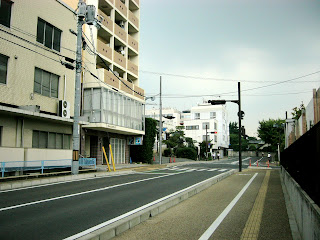
A 4-story modern building located directly between the Hayashihara Art Museum and the Inner Moat:

3. Rebuild the Okayama Shimin Kaikan

The Shimin Kaikan is a vital gathering place for our community and could play an important role in a future Marunouchi Historical Park. Assuming Sakakibara Hospital and other buildings could eventually be removed, the Shimin Kaikan building would also need to be torn down in order to clear the view toward Okayama Castle. However, it could be replaced in this same location by a new Shimin Kaikan in traditional Japanese style, built lower to the ground so as not to block the sight line, and with windows opening out toward the river:

A low-profile Shimin Kaikan would not accommodate very large public gatherings, but other facilities now redundantly serve this purpose, including the nearby Okayama Symphony Hall.
4. Install other facilities in the park to make it a center of cultural activity
a) An open-air theater
The site of Sakakibara Hospital and its parking lots offers a hillside setting with wide-open views over Okayama Castle and the Asahi River - perfect for an open-air amphitheater. Consider the example of the famous Greek theater in Taormina, Sicily:

The theater in Taormina is built on a pre-existing slope, whose higher points have a commanding view over Mt. Etna and the Ionian Sea. No one will ever confuse Okayama with Taormina, but on a humbler scale, our town offers its own setting for an open-air amphitheater. The old earthworks now covered by the Sakakibara Hospital parking lot provide a natural slope with a sweeping vista:









Here is a Japanese example of an open-air amphitheater:

This theater is part of the Shikoku Mura, a complex of traditional buildings assembled in a park at Yashima near Takamatsu, Kagawa Prefecture. The principle behind the creation of Shikoku Mura was to bring together a variety of traditional structures where they could be easily accessed and enjoyed by tourists and by the residents of Takamatsu. Because the villages where these buildings originated could no longer afford to maintain them, gathering the buildings into a convenient central location was as beneficial to these villages as it was to the city of Takamatsu. We should ask ourselves whether Okayama City could work out a similar arrangement with owners of traditional properties in this prefecture in order to enhance the beauty and architectural significance of a future Marunouchi Historical Park. Surely there are at least a few such owners who would like to dispose of their traditional buildings if they could find someone to buy them.
Other examples of outdoor theaters in Japan (might there be such a building somewhere in Okayama, in need of a new home?):


Other ideas for using the space that could be cleared by relocating Sakakibara Hospital include:
b) an open-air pavilion
Compare the first photo, the existing gazebo overlooking the Asahi River from Ishiyama Koen, with the second photo, an open-air pavilion located on a hillside in Yamagata:


c) a bandstand
This bandstand overlooks the Harbour Bridge in Sydney:


This bandstand is located on the coast of Massachusetts, USA:

Including these kinds of facilities in a future Marunouchi Historical Park would provide an ideal setting for free concerts and performances that can be enjoyed by residents and tourists alike.
5. Redevelop the former Uchisange Elementary School
The yellow pushpin indicates the site of the former school:

The former Uchisange Elementary School offers a superb site for redevelopment. The school is located at the intersection of Okayama's historical and modern districts, and has a direct view toward the Asahi River and Tsukimi-bashi. Assuming obstructing buildings are cleared, this site would also command a view down the length of Momotaro-dori. The former school's precincts are bounded by the Nishimaru defensive earthworks, and contain the remains of the Ishiyama Gate (a former National Treasure) and the Nishite Yagura, a nationally-registered Important Cultural Property. This large hilltop site offers the best location in Okayama for the development of an upscale hotel or ryokan.
Here are some photos of the former Uchisange Elementary School site:









Okayama should impose strict guidelines on any development of this site. First of all, the developers should preserve in perpetuity the historic earthworks and the Nishite Yagura. Second, they should design their buildings to respect the historical character of the district and to maintain a clear line of sight from Momotaro-dori toward Okayama Castle. Finally, they should restore the traditional appearance of the parapets that surmount the earthworks:

6. Relocate Uchisange Kindergarten
The Uchisange Kindergarten is situated at the southwest corner of the Inner Moat and has an unobstructed view toward Okayama Castle, Tsukimi-bashi, and the Hayashihara Art Museum. Indeed, the children who are lucky enough to attend this school enjoy one of the loveliest views in the entire city. This unique site should be redeveloped for a more appropriate use, such as a teahouse or cafe. Built in an architectural style that blends with its historical surroundings, this moatside kissaten would become a popular stopping point for visitors to the castle area and would help complete the tourist "circuit" from the Korakuen to the castle to the Hayashihara Art Museum.
The base of the kindergarten incorporates an historic (or at least historic-looking) stone wall:


The kindergarten looks out over the Inner Moat...

...and has a direct view of Tsukimi-bashi:

This is the view in the opposite direction, from Tsukimi-bashi:


The large brown building directly behind the kindergarten in the previous photo is the lovely Okayama Prefectural Library. As you can see in the next two photos, the kindergarten blocks the view from inside the library out toward the moat and Tsukimi-bashi:


In short, the kindergarten is not aesthetically or functionally appropriate for this location. With all due respect to the families that use this facility, it would be in the best interests of the city to relocate it, and to replace it with a structure that will blend in with the historical surroundings and with the superbly-designed Prefectural Library.
7. Apply a design code to private homes within the Historical Park
Marunouchi contains a significant cluster of historic homes. Most of these have maintained their beautiful traditional-style exteriors, but a few have added less expensive walls, tiles or fixtures that clash with design of the other homes and with the castle buildings. To enhance the historic appearance of this area, the city should encourage the neighborhood to adopt a strict design code, and provide funds to homeowners who need to make cosmetic adjustments in order to meet the code. With adequate funds to compensate homeowners for their expenses and trouble, the design code can be of benefit to these homeowners as well as to the wider community.
8. Get parking lots under control
The area proposed for the Marunouchi Historical Park is riddled with parking lots today.
In the following aerial photograph, the first three yellow markers inside Ujo-koen (in the upper right of the picture) are not officially parking lots, but cars are often parked there. Also, in some places two markers may indicate what is officially a single lot. As always, click on the photo for a larger image.

Obviously, there must be some parking in this area. For one thing, people who live or operate businesses in this district need a place to park. Also, we need to allow for parking by tourists and tour buses, such as at the lot on the southwest corner of the Inner Moat. Beyond that, parking in this zone should be reduced to the absolute minimum. The automobile has already taken over most of Okayama, but at least in the historical heart of the city, let us prevent that fate.
Among the parking lots to eliminate would be those of the Sakakibara Hospital, and the one located directly between the Inner Moat and the Asahi River, at the far right of the aerial photograph above (marked with the eyedropper).
The latter has a pretty view over the moat...

...seen only from the back of these parked cars:
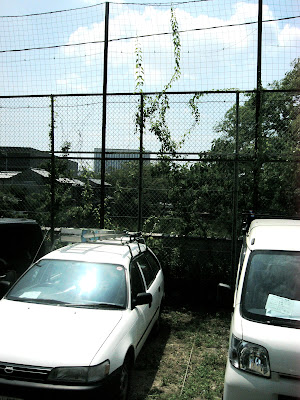
This parking lot looks out not only over the moat, but also over the river, the castle, and a number of traditional homes. It is another one of the Marunouchi district's special and beautiful places, a perfect spot for a tea room or open-air pavilion looking out over the water:

9. Emulate the example of the Prefectural Library

Okayama Prefecture deserves congratulations for its splendid new library. The building blends in with and enhances the special features of the surrounding area, to which the architects clearly paid careful attention. Note in particular how the architects...
a) incorporated a moat:

b) made use of and even partially rebuilt the existing defensive earthwork:



c) borrowed the castle wall motif with rough-textured stone cladding on the exterior columns (next 2 photos) and the south wall of the moat (3rd photo), which doubles as a bench:

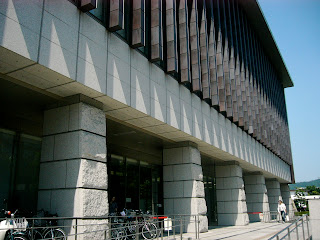

d) built in sweeping views toward the castle:



e) blended in with the color of the castle and the color & design of the Prefectural Office across the street:

The library makes for a perfect neighbor to Okayama Castle and the perfect transition between the Castle and the enormous Prefectural Office. Now if we could only relocate the kindergarten that stands between the Library and the Castle!

From the architects of the Prefectural Library we have received not only a beautiful and very useful library, but also a lesson in how best to manage one's architectural heritage:
preserve it
display it
blend in with it
be inspired by it
display it
blend in with it
be inspired by it
Let us remember the name of this library's architect the next time we need help for a redevelopment project in this area, such as for a new Shimin Kaikan or for a building to replace the Uchisange Kindergarten.

Respecting property owners' rights
While we look to convert the Marunouchi historical district to more appropriate uses, we must respect the rights of owners whose properties we seek to relocate. These owners have made considerable investments in their properties under the reasonable expectation that they would be able to operate in their present locations on a permanent basis. With the utmost respect for these investments and for laws that protect the rights of property owners such as Sakakibara Hospital, Uchisange Kindergarten, and the RSK television studio, let us work with these owners to relocate their properties over an appropriate timeframe.
Financing
Relocating and refurbishing structures in the Marunouchi area will require considerable investment and political will on the part of the public. This effort would take not years but decades to complete. But we should not put off this task any longer. To achieve this long-term goal, let us work with our leaders to set aside a Marunouchi Historical Park "superfund," and to explore creative financing options that will allow private property owners and all the residents of Okayama to benefit from this project. In the long run, this project's potential for encouraging tourism and entertainment-related development will more than repay the cost of paying property owners to refurbish, rebuild, or relocate.
In conclusion...
...let us work with our city’s leadership to preserve, restore, and enhance the historical Marunouchi district over the long term. This project will outlast the incumbency of our governmental leaders, so its success will depend on the sustained political will of concerned residents and supporters of Okayama. Let us take a first step toward this goal by working out a shared long-term vision for Marunouchi in discussion with the area’s residents and property owners, and prohibiting any redevelopment that does not accord with this shared vision.
P.S.: History buried
To wrap up this posting, here are a few other examples of how our city's historic charm has become obscured:
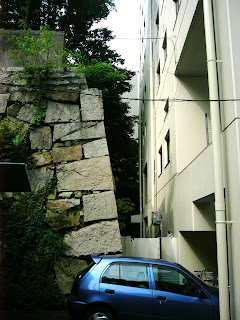







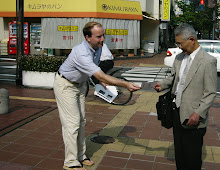
No comments:
Post a Comment